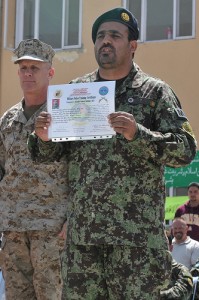Rumored Satellite Imagery of Parchin “Clean-Up” Fails to Materialize, Claim Debunked
Back on March 7, AP’s Vienna correspondent George Jahn wrote that two diplomats, described as “nuclear experts accredited to the International Atomic Energy Agency” informed him that they had seen satellite imagery showing evidence of Iran trying to clean the disputed Parchin site of presumed radioactive contamination arising from work to develop a neutron trigger for a nuclear weapon. Writing yesterday for IPS News, Gareth Porter debunked Jahn’s claims. Porter’s conclusions are buttressed by the fact that David Albright’s ISIS, which Porter notes has published satellite imagery of the Parchin site since 2004 in its efforts to prove Iran is working on a nuclear weapon, has not published any imagery relating to the “clean-up” claims.
Jahn’s March 7 piece opens bluntly:
Satellite images of an Iranian military facility appear to show trucks and earth-moving vehicles at the site, indicating an attempted cleanup of radioactive traces possibly left by tests of a nuclear-weapon trigger, diplomats told the Associated Press on Wednesday.
But a bit later, Jahn does admit not all the “diplomats” he spoke to agreed on what the photos revealed:
Two of the diplomats said the crews at the Parchin military site may be trying to erase evidence of tests of a small experimental neutron device used to set off a nuclear explosion. A third diplomat could not confirm that but said any attempt to trigger a so-called neutron initiator could only be in the context of trying to develop nuclear arms.
One major problem with taking the tack of accusing Iran of trying to develop a neutron trigger is that until now, the loudest accusations relating to the Parchin site have centered around development of a high-explosives based trigger. See, for example, this post where I discuss claims from Benjamin Netanyahu, David Albright and Joby Warrick that high explosives work was aimed at a trigger rather than production of nanodiamonds.
But another huge problem with the claim of Iran trying to clean the site is the impossibility of clean-up itself. Jahn even inadvertently gives us a clue:
Iran has previously attempted to clean up sites considered suspicious by world powers worried about Tehran’s nuclear ambitions.
Iran razed the Lavizan Shian complex in northern Iran before allowing IAEA inspectors to visit the suspected repository of military procured equipment that could be used in a nuclear weapons program. Tehran said the site had been demolished to make way for a park, but inspectors who subsequently came to the site five years ago found traces of uranium enriched to or near the level used in making the core of nuclear warheads.
A spokesman for Iran’s Foreign Ministry clearly explained that such evidence cannot be completely removed : Read more →


